Fire and Earthquake Prevention
For a safe dormitory life, dormitory users should be familiar with fire prevention and action in case of fire.
Tips in case of fire
- Fire notification
-
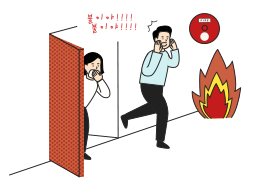
- Screaming "fire" to notify people around you (Or ask for help from a life teacher.) Press the "Push" switch on the transmitter in the nearby fire hydrant Turn off fire as soon as possible using nearby fire extinguishers and fire hydrants If the initial fire extinguishment has failed and the fire has expanded, report it to the fire department 119
- Emergency evacuation facility and fire escape in dormitory
-

- Fire extinguishers are placed throughout the building, including corridors and public spaces, and sprinklers are automatically activated when a fire is detected. Emergency evacuation is located inside each room door and must be familiar with it. In the event of a fire, the elevator must be evacuated through the stairs along the green exit sign, and the elevator must never be used. (it may stop when blackout begins) If you can not evacuate downstairs, go to rooftop, If it is difficult to get out of the apartment, evacuate to the next apartment through a lightweight partition installed between the apartments, or evacuate to the evacuation space within the apartment.
Emergency evacuation tips
- You must remember two or more evacuation routes.
- In case of fire, do not panic but calmly evacuate to an emergency exit (following light in low posture, evacuation along the guidance sign)
- Smoke has a characteristic of moving upwards, so use a towel dampened with water to block your nose and move along the wall in low posture
- Before opening handle of door, if it is hot, you have to find another route.
- When your clothes are caught on fire, you should cover your eyes and mouth and roll around on the floor
- When it is difficult to use the escape staircase, evacuate as you consider the place where fire occurs
- If your location is above the place where fire occurs, then go to rooftop
- If your location is below the place where fire occurs, then go to 1st floor
- If evacuation routes and emergency stairs are blocked, use descending health line installed in each apartment
How to use fire extinguisher
-
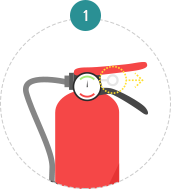 Pull out safefy pin
Pull out safefy pin
-

-
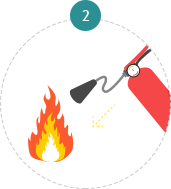 Hold nozzle and point it to the fire
Hold nozzle and point it to the fire
-

-
 Grab handle
Grab handle
-

-
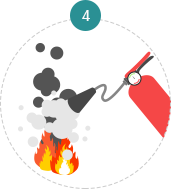 Shoot powder around fire
Shoot powder around fire
How to use indoor fire hydrant
-
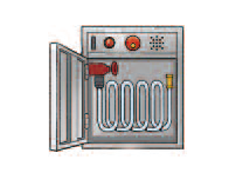 Open the door
Open the door
-
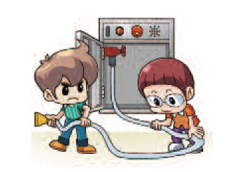 Remove hose and hold nozzle
Remove hose and hold nozzle
-
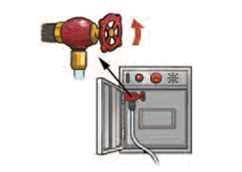 Turn valve
Turn valve
-
 Shoot to the fire
Shoot to the fire
Usual Fire Prevention Tips
- Absolutely no smoking in the dormitory building (including toilet, rest room, veranda)
- Learn how to use the fire extinguisher in ordinary day
- No flammable materials in apartment
- Usually, the emergency stairway door remains closed.
- Switch off and unplug when not using electrical appliances
- Never use heating apparatus and electric fan
- Prohibition of use of electric machine, furniture, etc. that are not under specification ("Check", "verified", "KS" check)
- Do not use many consents at once
Evacuation Tip in earthquake
- When an earthquake occurs, it must be just one or two minute with huge shock, so protect the body under the table during this time, and when there is no table, protect your head with a cushion.
- Open the door not to block the exit and shut down gas / electricity.
- When there is a fire, you should stay calm and quickly extinguish fire
- When an earthquake strikes, it is very dangerous because of falling windows or signboards, so you should not rush out.
- When an earthquake or fire occurs, do not use the elevator and if you are in elevator, push all buttons and go outside at first stop.
- If you are trapped, ask for rescue by interphone.
- After the huge vibration stops, you must evacuate to a large space such as an open space or a park. Also, blocky walls, vending machines and other unfixed objects may fall, so do not go near them.
Earthquake-related Dormitory Preparation inside apartment
- Get to know the evacuation site: under my desk in the room Avoid falling objects or cushions, pillows, or helmets to protect your head
- Do not place heavy objects or glassware on elevated place Heavy items are kept in the bottom, 3rd shelf and 4th shelf storage
-
Fragile glassware must be kept thoroughly
Broken glass fragments can be a risk if urgent (glasses, glass cups, glass frames, mirrors, monitors, water bottles,
wall clocks, etc.) - Keep personal safety supplies in case you need to evacuate. Safety cap: Head protection from falling objects (school safety team will be provided) Thick indoor slippers: Protecting feet from glass fragments Emergency lighting: Use when a power failure occurs (cell phone lights can also be used) Others: Evacuation and personal medication
- Remember the location of the power breaker and gas valve 1st and 2nd building: Gas valve (veranda), Power breaker (in shoe box) 3rd building: Gas valve (veranda), power breaker (near the wall opposite the shoe box) 4th: Gas valve (veranda), power breaker (indoor wall)

